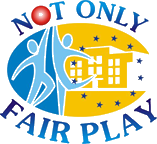
- Home
- Best
Practices - Toolkits
How to ... - Sport
Events - Guidelines
- Information
& Contacts - Project Management
A collection of student stories and initiatives about sport.
This section offers access to a collection of toolkits to promote sport at school.
-
 Physical Education Teachers
They are the main point of reference for students at school
Physical Education Teachers
They are the main point of reference for students at school
-
 Teachers
Teachers of all subjects can contribute to promote sport at school
Teachers
Teachers of all subjects can contribute to promote sport at school
-
 School Directors
Their support is a key element to promote sport at school
School Directors
Their support is a key element to promote sport at school
-
 Resources
A database of resources for teachers, PE teachers and school directors for the promotion of sport at school.
Resources
A database of resources for teachers, PE teachers and school directors for the promotion of sport at school.
Sporting events are organised in each partner country
Guidelines for policy makers willing to raise awareness on the importance of promoting sport in schools
Events
The Not Only Fair Play project has been promoted through conferences and articles.
Partnership
-
 Contractual Partners
From this section it is possible to access a description of each contractual partner of the Not Only Fair Play project.
Contractual Partners
From this section it is possible to access a description of each contractual partner of the Not Only Fair Play project.
-
 Schools
From this section it is possible to access information about the schools involved in the Not Only Fair Play Project in the 9 European countries involved.
Schools
From this section it is possible to access information about the schools involved in the Not Only Fair Play Project in the 9 European countries involved.
-
 Associated Partners
A number of associated partners officially joined the project in order to ensure the project sustainability by continuing to use the project deliverables over the next years.
Associated Partners
A number of associated partners officially joined the project in order to ensure the project sustainability by continuing to use the project deliverables over the next years.
This section of the Not Only Fair Play portal provides administrative information for the project contractual partners and for the European Commission, and is password protected.
School Directors
Homepage > Toolkits > School Directors

Their support is a key element to promote sport at school
Back to the School Directors Toolkits
How to promote the importance of sport at school
A Toolkit for School Director
Strategies:
• use a multi-component approach to promoting physical activity to support change and development.
• use strategies that combine educational, curricular and environmental elements, for example, additional PE lessons, cross curricular activities and playground markings.
• focus on increasing the variety of physical activity opportunities available throughout the day, for example, measures to increase active travel, daily activity sessions, active classroom breaks and physical activity homework.
• Include elements of behaviour change such as goal setting and self-monitoring alongside additional physical activity opportunities.
- Effect of school-based interventions on physical activity and fitness in children and adolescentsThe document aims to summarize recent reviews with the aim of increasing PA or fitness in youth and carry out a systematic review of new intervention studies.
- Promoting physical activity in schoolsThe documents illustrate how selected health issues can serve as entry points in planning, implementing, and evaluating health interventions as part of the development of a health-promoting school.
- Physical education frameworkThe document shows PE education framework for classes from primary to secondary school. Focused on the model content standards and supported by current research, the framework emphasizes student learning with the goal of helping every student adopt a physically active lifestyle.
- Social-ecological model to physical educationThe document is a guidelines to components of social-ecological models: (individual, social environment, physical environment and policy); the relationship between the multiple levels of influence and physical activity.


